Ministry of Heritage and Culture
The Ministry of Heritage and Tourism (MOHT) is the governmental body in the Sultanate of Oman responsible for promoting and preserving Omani heritage and tourism.
| وزارة التراث و السياحة | |
 | |
| Agency overview | |
|---|---|
| Jurisdiction | Government of Oman |
| Headquarters | Muscat |
| Agency executive |
|
| Child agency |
|
| Website | Official website |
 |
|---|
| This article is part of a series on the politics and government of Oman |
|
|
| Cabinet |
|
|
The current Minister of Heritage and Tourism is Salem bin Mohammed Al Mahrooqi.[1][2]
History
The first governmental body to be officially concerned with heritage and culture was the Ministry of Information and Culture (its name at the time) in accordance with the responsibilities assigned to it in the year 1975 by Royal Decree No 26/75.[3] Some of these responsibilities were moved out of the Ministry of Information and Culture to the Ministry of Royal Court Affairs (its name at the time) by Royal Decree No 12/76[4] by transferring the Directorate of Heritage Collection to the Ministry of Royal Court Affairs. Then in the year 1975 Faisal bin Ali Al Said was appointed as the Minister of Omani Heritage who took over all heritage and cultural responsibilities.[5]
The name of the Ministry of Omani Heritage was changed in the same year of its establishment to the Ministry of National Heritage and Culture,[6] which in turn was later renamed to the Ministry of Heritage and Culture in the year 2002.[7]
Function
The competences of MOHC are as follows:[8][9]
- Discovering and maintaining cultural monuments and supervising the works of archeological missions.
- Surveying, restoring and maintaining historical forts and buildings.
- Establishing historical museums.
- Discovering historical manuscripts and creating libraries for public access.
- Preserving Omani heritage articles and facilitating their exploitation.
- Supporting the participation of the private sector in the process of preserving and exploiting heritage.
- Supporting traditional arts.
- Supporting the establishment of national cultural institutions.
- Developing the production of Omani artistic, literature, and intellectual works.
- Drawing strategies and programs to support the creative community.
- Supporting programs and projects concerned with authors.
- Issuing publications relating to the promotion of the awareness of heritage and culture.
- Auditing artistic works.
- Contributing to the process of enforcing intellectual property laws.
- Setting local, regional, and international cultural exhibitions and festivals.
- Carrying out specialized researches and studies in the field of history, heritage, and culture.
- Coordinating with Arab, regional, and international authorities and organizations related to the competences of the ministry.
- Representing the Sultanate at local, regional, and international conferences, symposiums, and meetings related to the competences of the ministry.
- Training the employees of the ministry.
Structure
MOHC has six Directorates-General:[8][10]
- The Directorate General For Monuments and Museums
- The Directorate General For Records and Manuscripts
- The Directorate General For Literature and Arts
- The Directorate General For Cultural Organizations and Relations
- The Directorate General For Culture and Heritage in Dhofar
- The Directorate General For Administrative and Financial Affairs
Former Senior Officers
- Faisal bin Ali Al Said - Appointed as Minister of National Heritage and Culture in 1976.[11]
- Mal Allah bin Ali bin Habib - Appointed as Undersecretary for the Ministry of National Heritage and Culture in 1982.[12]
- Salim bin Ismail bin Ali Al Suwaid - Appointed as Undersecretary for the Ministry of National Heritage and Culture in 1986,[13] then appointed as the Undersecretary for the Ministry of National Heritage and Culture for Cultural Affairs in 1991.[14]
- Mohammed bin Ahmed Al Harthy - Appointed as Undersecretary for the Ministry of National Heritage and Culture for Heritage Affairs in 1991.[14]
- Fatik bin Fahar bin Taimur Al Said - Appointed as Secretary-General For Traditional Arts in the year 1994.[15]
References
- "Cabinet of Ministers". Ministry of Information. Archived from the original on 22 December 2013. Retrieved 2 September 2012.
- Appointing a Minister of Heritage and Culture, Royal Decree No11/2002, issued on February 14, 2002, published in issue 713 of the Official Gazette
- Royal Decree No. 26/75 (Untitled), issued on June 28, 1975
- Royal Decree No. 12/76 (Untitled), issued on December 3, 1975.
- Royal Decree No 12/76 (Untitled), Issued on April 10, 1976.
- Royal Decree No. 14/76 (Untitled), Issued on April 12, 1976
- Modifying the Name of the Ministry of National Heritage and Culture, Royal Decree No 10/2002, issued on February 14, 2002, published in issue no 713 of the Official Gazette.
- "Specifying the Competences of the Ministry of Heritage and Culture and Adopting its Organizational Structure", Royal Decree No. 24/2005, issued on February 26, 2005, published in issue no. 786 of the Official Gazette.
- "Responsibilities of the Ministry of Heritage and Culture (Arabic)". Ministry of Heritage and Culture. Archived from the original on 20 December 2012. Retrieved 2 September 2012.
- "Organizational Structure and Administrative Divisions of the Ministry of Heritage and Culture (Arabic)". Ministry of Heritage and Culture. Archived from the original on 20 December 2012. Retrieved 2 September 2012.
- Royal Decree No 12/76 (Untitled), issued on April 10, 1976.
- Royal Decree No. 97/82 (Untitled), issued on December 9, 1982
- Appointing an Undersecretary and an Advisor to the Ministry of National Heritage and Culture, Royal Decree No. 3/86, issued on January 2, 1986.
- Appointing an Two Undersecretaries of the Ministry of National Heritage and Culture, Royal Decree No 121/91, issued on December 12, 1991.
- Appointing A Secretary General For Traditional Arts in the Ministry of National Heritage and Culture, Royal Decree No. 109/94, issued on October 31, 1994, published in issue no 538 of the Official Gazette
